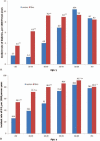A prospective study of impaired fasting glucose and type 2 diabetes in China: The Kailuan study
- PMID: 27861364
- PMCID: PMC5120921
- DOI: 10.1097/MD.0000000000005350
A prospective study of impaired fasting glucose and type 2 diabetes in China: The Kailuan study
Abstract
The worldwide prevalence and incidence of diabetes and obesity are increasing in pandemic proportions. This is particularly relevant for China, where an extremely large population is growing, aging, and urbanizing. We thus conducted a prospective study to examine the prevalence and incidence of impaired fasting glucose (IFG) and diabetes, the rate at which fasting blood glucose rises, and the major modifiable risk factors associated with these outcomes in a large Chinese population from the Kailuan prospective study.A prospective cohort included 100,279 Chinese participants, aged 18 years or more, who had available information on fasting blood glucose concentrations at the start of the study (2006). Examination surveys were conducted every 2 years in 2008 and 2010. For the analyses of incident diabetes, we included 76,869 participants who were free of diabetes, cardiovascular disease, and cancer at the baseline and participants in the 2008 and/or 2010 follow-up. Diabetes was defined by a fasting blood glucose concentration ≥7 mmol/L, self-reported history, or active treatment with insulin or any oral hypoglycemic agent. IFG was defined by a fasting blood glucose concentration between 5.6 and 6.9 mmol/L.During the 4-year study, the prevalence of diabetes and IFG rose from 6.6% to 7.7%, and 17.3% to 22.6%, respectively. There were 17,811 incident cases of IFG and 4867 incident cases of diabetes. The age-standardized incident rate of IFG and diabetes were 62.6/1000 person-years (51.2/1000 person-years in women and 73.8/1000 person-years in men) and 10.0/1000 person-years (7.8/1000 person-years in women and 12.1/1000 person-years in men), respectively. We observed steady increases in fasting blood glucose with body anthropometrics and in every defined category of body mass index, including in those traditionally considered to be well within the "normal" range.In this large longitudinal study of Chinese adults, we observed a high prevalence and incidence of IFG and diabetes over 4 years of follow-up. Our findings are alarming for Chinese public health since steady rises in fasting blood glucose were seen across all permutations of body habitus, even apparently very lean individuals.
Conflict of interest statement
All authors have completed and submitted the ICMJE form for disclosure of potential conflicts of interest and none were reported.
Figures



References
-
- Hossain P, Kawar B, El Nahas M. Obesity and diabetes in the developing world—a growing challenge. N Engl J Med 2007; 356:213–215. - PubMed
-
- Wild S, Roglic G, Green A, et al. Global prevalence of diabetes: estimates for the year 2000 and projections for 2030. Diabetes Care 2004; 27:1047–1053. - PubMed
-
- U.S. Department of Health and Human Services, CDC, U.S. Department of Health and Human Services, CDC National Diabetes Fact Sheet: National Estimates and General Information on Diabetes and Prediabetes in the United States, 2011. 2011; http://www.cdc.gov/diabetes/pubs/pdf/ndfs_2011.pdfhttp://www.cdc.gov/diabetes/pubs/pdf/ndfs_2011.pdf (accessed Sep 1st, 2015).
-
- He J, Gu D, Wu X, et al. Major causes of death among men and women in China. N Engl J Med 2005; 353:1124–1134. - PubMed
-
- Wen CP, Cheng TY, Tsai SP, et al. Increased mortality risks of pre-diabetes (impaired fasting glucose) in Taiwan. Diabetes Care 2005; 28:2756–2761. - PubMed
MeSH terms
Substances
Grants and funding
LinkOut - more resources
Full Text Sources
Other Literature Sources
Medical

